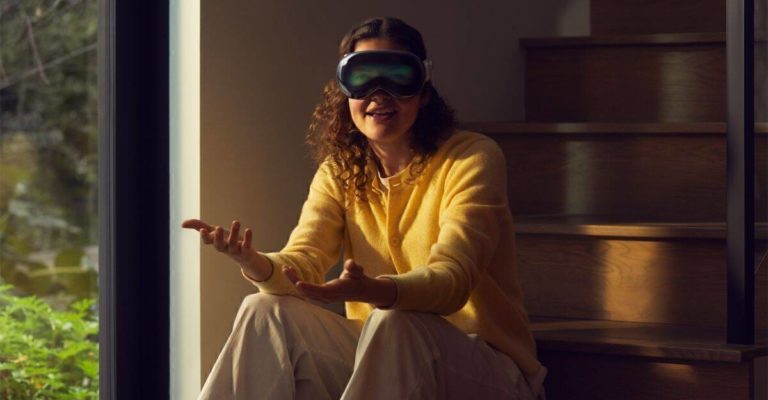
Apple’s Vision Pro - Bitte nicht lachen!
This article first appeared on W&V Online.
Currently, no one can escape the product release of the new tech gadget from Apple. The announcement of the device had already made waves last year and has been officially available for purchase since February 2nd (at least in America). And as if someone pressed a button, a wave of YouTube videos, memes, tech reviews, opinions, and social media posts are now flooding the public, often revealing a skeptical and sometimes mocking view of the new smart glasses.

Of course, it's easy to make fun of it. Nerds ride the subway with these glasses, making awkward gestures. Another films the reactions of passing pedestrians. A tech influencer compares the color accuracy of reality with the video representation of the Pass-Through and soberly notes that reality indeed has more colors, and another points out the unnaturalness of the eye projection on the external display. And if you still haven't had enough of the criticism, just take a look at the comments and imagine you're in a new episode of Black Mirror.
The Apple Vision Pro is for Professionals
And I understand all of this. It's unusual, and not every use case with the glasses really makes sense. However, I believe that all the tech reviews and the current influencer content convey a distorted idea of the product. When an influencer films themselves walking through Times Square with the glasses, it primarily serves their followers and caters to the attention mechanisms of their market. But you should realize one thing: the glasses cost almost $4,000. It's extremely unlikely that anyone who doesn't have a professional connection with it would buy these glasses. It is even less likely that this person will walk around New York wearing these glasses. So, an image is created that does not do justice to the matter. The glasses are not meant as a tool for everyone. That's why it's called "Pro." But following the current reports on the net, one might get the impression that this is exactly Apple's intention. It is not.
The Apple Vision Pro Represents the Full Scope of a Digital Office Routine
When looking at the Apple Vision Pro, you have to think in a different direction. Unlike other VR glasses on the market, Apple's glasses come with a complete computer work infrastructure. Users are not just using proprietary application software with limited usable content. With the Apple Vision Pro, users have the full scope of a digital office routine depicted: emails, video calls, presentation software, spreadsheets, etc. And not just as another end device, but with the option to integrate physical space and virtual spaces into the digital workplace.
Reality, Digital Communication, and One's Own Work Merge into One Tool
So there's no need to make fun of the fake facial expressions of the artificially generated avatars. The glasses do not intend to replace FaceTime video calls or physical meetings. The virtual twin of the users exists purely for UX design reasons. What are you supposed to do if you receive a call while you are in a work situation? Quickly take off your glasses, open your computer, do your hair beforehand and then find your focus again after the call to continue working in a separate environment? That's not the idea behind a mixed reality tool like this. Rather, the idea is that all levels - reality, digital communication and your own work - merge into one tool. The artificial image of one's own self is the missing link that makes natural collaboration with other colleagues in a digitally expanded space possible in the first place.

The same applies to the external display. Anyone who has ever used a VR headset with a passthrough function knows the situation when people in the same room don't know whether you can perceive them or your surroundings. While this leads to amusing encounters, it's naturally a constant distraction for the users and also for others in the room.
Apple has done exactly what they always do with their product design: by drawing an analogy from reality, they've minimized another user experience hurdle. This design principle is called skeuomorphism and is the reason why Apple's first calendar looked like a Filofax. Of course, one couldn't flip through it, but the idea of entering appointments in an overview was explained without explicitly saying so. So, it's not primarily about whether the eyes look natural; it's about there being eyes at all.
Battery: Not Integrated, but Improved Wearing Comfort
The battery also receives much criticism. Not only because it is not integrated and is connected by a cable, but also because of the supposedly short battery life of 2 hours. I'm sure Apple will improve this in further iterations. However, Apple has taken great care to ensure that the weight does not become too high for the user, thus improving wearing comfort. Additionally, depending on the work situation, the size of the battery can be easily changed, or for longer usage times, completely swapped. This is not readily possible with permanently installed batteries.

Moreover, you need to be aware that all VR glasses require a permanently high level of computing power. Not only does the computing power have to be used for the apps, but these goggles constantly create a virtual space and calculate all the elements in it in real time. Imagine playing a demanding 3D game on your phone and streaming it simultaneously in a video conference. Our smartphones would all be at 25% remaining battery after an hour. But clearly, one cannot manage an 8-hour workday with the battery of VR glasses. But is that really a problem? My laptop is plugged in all day, and I only use the battery in meeting rooms or on the go.
Of course, the latest VR devices represent a new category in the use of digital tools. Dealing with them must be understood and learned, and this will eventually lead to acceptance by many people. When the iPhone was invented, many people wondered why they needed the touch display, and many stuck with button phones. If you look at the usage behavior of smartphones today, making calls is a secondary function.
Upcoming Use Cases Will Reveal the Purpose of the Glasses
In the coming months, we will see more and more use cases that clarify the actual purpose of the glasses. Companies with remotely living employees will realize that $4,000 per device costs less than 3 intercontinental business flights per year. People with limited mobility will be able to participate more inclusively in society, and many learning applications as well as game apps will provide education, further training, and entertainment.
How relevant the product is from Apple's perspective is shown by the American online store. The glasses have gotten their own spot in the main menu, right next to the iPhone and the Apple Watch. It's a new category. Not just for the online store - but also for the company and us humans.

